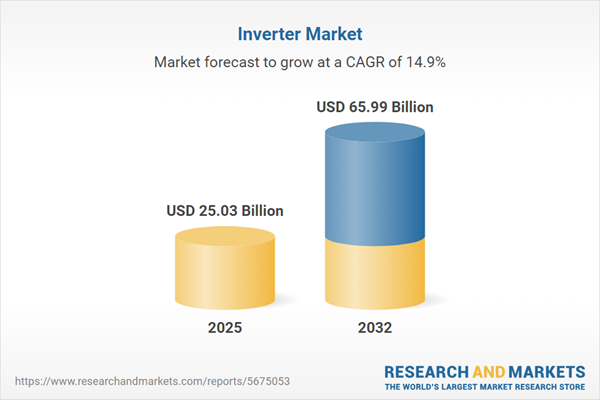Speak directly to the analyst to clarify any post sales queries you may have.
The inverter market has entered a transformative period, driven by widespread energy transition and rapid innovation. Senior decision-makers now face a landscape where inverters do more than manage energy flow; they anchor resilient, intelligent, and sustainable power infrastructure.
Market Snapshot: Inverter Market Size and Growth Outlook
The inverter market grew from USD 21.79 billion in 2024 to USD 25.03 billion in 2025. It is projected to maintain a compound annual growth rate (CAGR) of 14.85%, reaching USD 65.99 billion by 2032. Market expansion reflects the growing role of advanced inverter solutions in global energy systems and a deepening focus on grid modernization and sustainability.
Scope & Segmentation
- Product Types: Central inverter, hybrid inverter, microinverter, string inverter
- Applications: Commercial (large business, small business), industrial (heavy industry, light industry), residential (single family, multi family), utility scale (floating, ground mounted)
- Installation Types: Hybrid (solar with battery storage, solar with diesel generator), off grid (solar standalone, solar with wind), on grid
- Phase Options: Single phase, three phase
- Power Ratings:
- High power: 50-200 KW, above 200 KW
- Medium power: 5-20 KW, 20-50 KW
- Low power: under 3 KW, 3-5 KW
- Regional Coverage: Americas (United States, Canada, Mexico, Brazil, Argentina, Chile, Colombia, Peru), Europe, Middle East & Africa (United Kingdom, Germany, France, Russia, Italy, Spain, Netherlands, Sweden, Poland, Switzerland, United Arab Emirates, Saudi Arabia, Qatar, Turkey, Israel, South Africa, Nigeria, Egypt, Kenya), Asia-Pacific (China, India, Japan, Australia, South Korea, Indonesia, Thailand, Malaysia, Singapore, Taiwan)
- Leading Companies: Sungrow Power Supply Co., Ltd., Huawei Digital Power Technologies Co., Ltd., SolarEdge Technologies, Inc., SMA Solar Technology AG, Growatt New Energy Co., Ltd., Toshiba Mitsubishi-Electric Industrial Systems Corporation, ABB Ltd, Schneider Electric SE, GoodWe Power Supply Technology Co., Ltd., Fronius International GmbH
Key Takeaways for Decision-Makers
- Inverters have evolved into essential grid elements, enabling smart monitoring, grid support, and integration of energy storage across sectors.
- Advanced power electronics, including wide-bandgap semiconductors, are improving inverter efficiency and reducing operational costs.
- Artificial intelligence and machine learning strengthen inverter functions, empowering operators with predictive maintenance and adaptive control.
- Segment-specific solutions, such as hybrid and microinverter configurations, are meeting the complex needs of commercial, industrial, and residential clients.
- Regional policies and incentive programs are increasing demand for smart inverter functionalities that promote resilience and flexibility in local energy grids.
- Market leaders are pursuing vertical integration, software innovation, and extended service packages to differentiate in a highly competitive landscape.
Tariff Impact: U.S. Policy and Supply Chain Resilience
Recent U.S. tariff measures have raised supply chain costs, prompting many manufacturers to consider local assembly and alternative sourcing strategies. These changes have reshaped production footprints and component pricing, prompting vendors to explore efficiencies in scale and integration. As a result, solution providers are emphasizing unique value-added offerings and innovative financing arrangements to maintain competitiveness under new cost pressures.
Methodology & Data Sources
This analysis uses a combination of in-depth primary interviews with industry experts and secondary data drawn from technical papers, corporate disclosures, and policy documentation. Data triangulation ensures robust validation of findings, while both quantitative and qualitative inputs inform market segmentation, technology trends, and regional analysis.
The Inverter Market: Why This Report Matters
- Enables executives to benchmark product and technology strategies against leading global competitors
- Provides insights into regulatory, supply chain, and market dynamics critical for informed investment and procurement decisions
- Equips organizations to adapt to evolving tariff environments and identify regional growth opportunities in fast-changing markets
Conclusion
With inverters at the core of modern energy infrastructure, leaders who align strategies to technology advancements and policy shifts will realize new growth opportunities. This report delivers the actionable intelligence needed to secure a stronger market position amid ongoing industry transformation.
Additional Product Information:
- Purchase of this report includes 1 year online access with quarterly updates.
- This report can be updated on request. Please contact our Customer Experience team using the Ask a Question widget on our website.
Table of Contents
3. Executive Summary
4. Market Overview
7. Cumulative Impact of Artificial Intelligence 2025
List of Figures
Companies Mentioned
The companies profiled in this Inverter market report include:- Sungrow Power Supply Co., Ltd.
- Huawei Digital Power Technologies Co., Ltd.
- SolarEdge Technologies, Inc.
- SMA Solar Technology AG
- Growatt New Energy Co., Ltd.
- Toshiba Mitsubishi-Electric Industrial Systems Corporation
- ABB Ltd
- Schneider Electric SE
- GoodWe Power Supply Technology Co., Ltd.
- Fronius International GmbH
Table Information
| Report Attribute | Details |
|---|---|
| No. of Pages | 190 |
| Published | October 2025 |
| Forecast Period | 2025 - 2032 |
| Estimated Market Value ( USD | $ 25.03 Billion |
| Forecasted Market Value ( USD | $ 65.99 Billion |
| Compound Annual Growth Rate | 14.8% |
| Regions Covered | Global |
| No. of Companies Mentioned | 11 |









